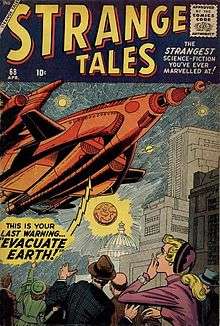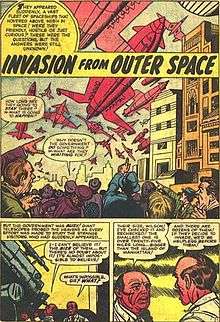Christopher Rule
| Christopher Rule | |
|---|---|
| Born | November 23, 1894 |
| Died | April 1983 (aged 88) |
| Nationality | American |
| Area(s) | Penciller, Artist, Inker |
Christopher Rule (November 23, 1894 – April 1983)[1] was an American comic book artist active from the 1940s through at least 1960, and best known as the first regular Marvel Comics inker for comics artist Jack Kirby during the period fans and historians call the Silver Age of Comic Books.
Biography
Early life and career

After driving an ambulance in France during World War I,[2] Christopher Rule in the 1920s worked in comic strips[3] and fashion illustration.[4] For publisher S. Gabriel & Sons, Rule and Pelagia Doane illustrated a Pinocchio "put together book" in which gummed illustrations could be cut out and mounted on background sheets.[5] In 1943, Rule was a comic-book inker with the Jack Binder Studio, and also that year inked Fawcett Comics stories featuring the superheroes Mary Marvel and Mr. Scarlet.[6]
By 1944 he'd become a staff artist at Timely Comics, the forerunner of Marvel Comics during the period fans and historians call the Golden Age of Comic Books.[7] Rule worked in what was called the "animator bullpen", which produced such movie tie-in and original funny-animal comics as Terrytoons Comics, Mighty Mouse, and Animated Funny Comic-Tunes, and was separate from the superhero group producing comics featuring the Human Torch, the Sub-Mariner and Captain America.[8] Due to his work going unsigned, in the manner of the times, comprehensive credits are difficult if not impossible to ascertain. Rule's first confirmed credits are as inker of the one-page fashion filler "Junior Miss Steps Out..." and as penciler-inker of an eight-page story in the teen-romance comic Junior Miss #1 (Winter 1944).[9]
Rule continued to ink romance stories over such pencilers as George Klein, Mike Sekowsky, and Syd Shores in such comics as Faithful, Love Classics, and Love Tales. He expanded into other forms, including heroic adventure with the mythologically based superheroine Venus, inking Werner Roth on a story in Venus #10 (July 1950); and then into horror, inking penciler Sekowsky's story "Hands of Murder" in Adventures into Terror #4 (June 1951), from Marvel's 1950s iteration, Atlas Comics.[9]
Inker Joe Giella, who worked on staff at Timely for two years beginning circa 1946, recalled Rule at the time as "a very heavy, older fellow with grayish hair. He was a good friend of Mike Sekowsky's, and worked in the same room with Mike. He was kind of an intellectual".[10] Artist Gene Colan, a Marvel mainstay from 1946 on, described Rule as "kind of like a Santa Claus — a roly-poly guy who was very funny".[11] Echoed artist Stan Goldberg, "He had a great gift of gab and a magnificent vocabulary. [...] He was kind of like a Santa Claus and looked very important".[12]
Goldberg also recalled that by this time, Rule's wife had died after having scalded herself. Years later, Rule remarried.[2]
Atlas and Kirby

In a rare formal credit in a comic of that period, Rule is listed as "art associate" in the Atlas Comics title Girls' Life #4 (July 1954), under "editorial and art director" Stan Lee.[9] In that or a similar staff capacity throughout the 1950s, Rule inked in a variety of genres and forms, with known work that includes medieval adventure, inking Syd Shores' Black Knight and Crusader stories in Black Knight #5 (Dec. 1955); Westerns, inking Shores in Six-Gun Western #2 (March 1957); biography, drawing the feature "Famous Explorers of Space" in the successively named Space Squadron / Space Worlds;[13] and science fiction/fantasy, drawing a story each in Strange Tales #49 (Aug. 1956) and World of Fantasy #9 & #15 (Dec. 1957 & Dec. 1958), and inking Shores yet again in World of Suspense #6 (Feb. 1957). In a rare switch, Rule penciled a story that someone else (Vince Colletta) inked, in My Own Romance #63 (May 1958).[9]
Rule inked the first stories of industry great Jack Kirby when Kirby returned to the company for a long-term stay for the first time since 1941, when he had co-created Captain America with Joe Simon. Rule inked Kirby's premiere Atlas/Marvel cover and the accompanying seven-page story "I Discovered the Secret of the Flying Saucers" in Strange Worlds #1 (Dec. 1958),[9] the first of dozens of much-reprinted Kirby science-fiction and monster stories that preceded Kirby and writer-editor Lee's industry-changing superhero series The Fantastic Four. Rule would remain Kirby's regular, nearly exclusive inker as Atlas Comics segued into Marvel Comics, at which point Dick Ayers would become Kirby's most frequent inker during the company's early years.
Rule inked several Kirby "pre-superhero Marvel" stories, many of them reprinted in subsequent decades, in such comics as:[9]
- Journey into Mystery # 51-52, 54 & 56 (March–May, Sept. 1959 & Jan. 1960)
- Strange Tales # 67-70 (Feb.-Aug. 1959)
- Strange Worlds # 3 (Aug. 1959)
- Tales of Suspense # 2-4 & 6 (March–July & Nov. 1959)
- Tales to Astonish # 1 & 5-6 (Jan. & Sept.-Nov. 1959), and
- World of Fantasy # 15-16 & 18 (Dec. 1958 - Feb. & June 1959)
Rule as well inked the prolific Kirby on Western stories in Gunsmoke Western #51 and Kid Colt: Outlaw #86 (Sept. 1959), romance stories in Love Romances #85 (Jan. 1960), and war stories in Battle #66-67 (Oct.-Dec. 1959), plus many covers across all genres.[9]
Rule's last known confirmed credit is inking Kirby on the five-page story "What Was the Strange Power of Simon Drudd?" in Tales to Astonish #10 (Jan. 1960).[9]
Some comics historians theorize he may have been an inker on some portion of Kirby's landmark comic The Fantastic Four #1 (Nov. 1961), for which George Klein is the generally recognized, uncredited inker. The standard Grand Comics Database, for example, lists the inker credit as "George Klein?; Christopher Rule? ... George Klein, or Chris Rule have been suggested as the inker but there is no consensus."[14] Others note the long lag time between Rule's last confirmed credit and the Fantastic Four premiere.[15]
References
- ↑ Christopher Rule, Social Security Number 083-18-7290, at the Social Security Death Index via FamilySearch.org. Retrieved 02 Mar 2013.
- 1 2 Interview with Atlas/Marvel artist Stan Goldberg, Alter Ego #18 (Oct. 2002), p. 14
- ↑ Evanier, Mark. "Who Inked Fantastic Four #1?" POV Online (column), "The Jack FAQ", p.2, n.d. WebCitation archive.
- ↑ Goldberg, Alter Ego, pp.13-14
- ↑ "[Listing for author] Lorenzini, Carlo". Catalog of Copyright Entries. New Series: 1937, Part 1. Library of Congress. 1937. p. 813. Retrieved October 28, 2012.
- ↑ Bails, Jerry; Hames Ware. "Rule, Chris". Who's Who of American Comic Books 1928-1999. Archived from the original on February 23, 2013.
- ↑ Vassallo, Michael J. "A Timely Talk with Allen Bellman", Comicartville.com, 2005. WebCitation archive.
- ↑ "I Let People Do Their Jobs!': A Conversation with Vince Fago—Artist, Writer, and Third Editor-in-Chief of Timely/Marvel Comics". Alter Ego. 3 (11). TwoMorrows Publishing. November 2001. Archived from the original on November 24, 2009.
- 1 2 3 4 5 6 7 8 Chris Rule and Christopher Rule at the Grand Comics Database
- ↑ Joe Giella interview, Alter Ego # 52 (Sept. 2005), p. 6
- ↑ Gene Colan interview, Alter Ego # 52 (March 2006), p. 69
- ↑ Goldberg, Alter Ego #18, p. 13
- ↑ Vassallo, Michael J. "A Timely Talk with Allen Bellman", Comicartville Library, 2005, p. 3. WebCitation archive, first page.
- ↑ The Fantastic Four #1 at the Grand Comics Database
- ↑ Evanier, POV Online, believes the first two issues were inked solely by Klein, but notes that "Rule and Klein were close friends who often worked on each others' assignments". Note: The comic itself carries no formal credits, bearing only signatures for editor-writer Stan Lee and penciler Jack Kirby.